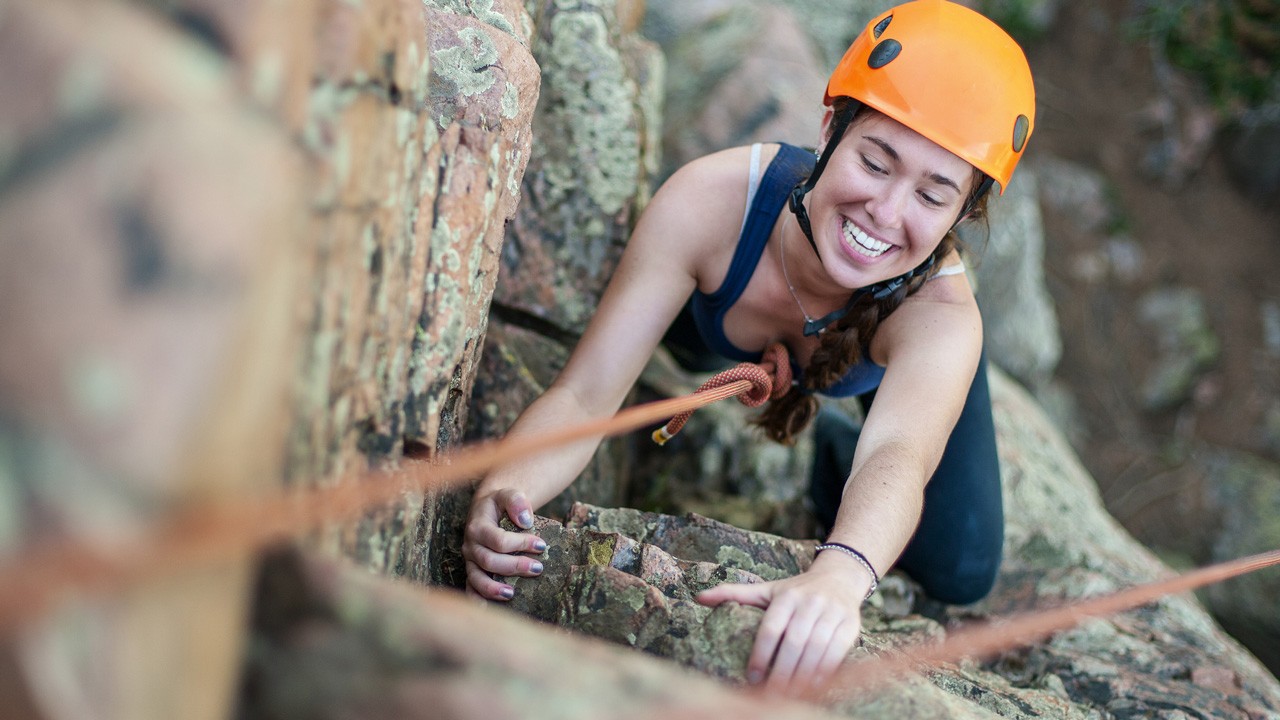Rock Climbing For Beginners
Expert advice on taking up this adventurous activity

Few sports offer the sort of excitement you can expect from rock climbing, whether that’s at an indoor climbing wall or scaling a mountain. That also means that it can seem like a daunting sport to try, with far greater risks than something like running or cycling. Getting involved can also be a trickier prospect, from finding where to do it to buying the kit you’ll need.
But if you can get over those small hurdles, rock climbing offers a fun and safe way to make friends and stay fit. It also opens up a whole new way to enjoy the outdoors, adding a dose of adrenaline and rewarding you with fantastic views – if you get high enough.
The main thing for beginners venturing into the world of rock climbing is to learn the ropes – literally. The best way to do this is to find a qualified instructor that can teach you the fundamentals of staying safe. Once you have the basics down there’s a wealth of information that can be accessed online, from tutorials to YouTube videos covering specific aspects of how to develop your skills.
In this guide, we’ll run through some of the most important information for beginners looking to take up climbing.
Getting Started With Climbing
Your local indoor climbing wall is a great place to start climbing and means that you can learn the basics in a safe and fun environment. Bouldering – low-level climbing without ropes – is a good way to begin honing the necessary skills, and all you need is a pair of climbing shoes and some chalk. Most walls will offer shoes for hire, so you don’t need to invest in a pair until you feel you’re ready.
If you want to try indoor climbing with ropes, then you’ll also need a harness, which can be hired from most climbing centres as well. Your local venue will also be able to provide you with an instructor to learn the basics, such as tying into the rope and belaying your partner.
The British Mountaineering Council (BMC) has a number of resources to help get you started, including finding your closest climbing wall.
Get the Coach Newsletter
Sign up for workout ideas, training advice, reviews of the latest gear and more.
Going From Indoor Walls To Outside
Climbing indoors is great fun and many people prefer to stick to those walls rather than ever heading to the great outdoors. For many, however, the prospect of climbing up some actual rock is the end goal. To do that you’ll need to make some adjustments. As well as requiring specialised kit, you’ll need to add some extra skills to your repertoire. One of the best ways to make the transition is to join a local mountaineering club where you’ll be able to find support and guidance from like-minded people. You can also book an instructor for a group introductory session.
Finding An Instructor
When looking for guidance to improve your skills you should ensure that you hire a qualified Rock Climbing Instructor or Rock Climbing Development Instructor. You’ll find these via the Mountain Training Association. If you want to do something a bit more adventurous such as a multi-pitch route you’ll need a mountaineering and climbing instructor or a British mountain guide. For indoor training use a qualified climbing wall instructor.
You can also consider attending events like the Arc’teryx Lakeland Academy. This annual weekend-long event aims to educate and share skills so that climbers can enjoy the crags safely. It includes clinics for complete beginners and runs several women-only sessions. It’s friendly, inclusive and has a welcoming low-key festival vibe. It’s also a great way to try kit for free before making expensive purchases.
Where And When To Go
The UK has loads of great places to climb, from big mountain multi-pitch routes to roadside single-pitch crags and sea cliffs. You can also climb on all rock types and do both sport and traditional climbing. For beginners, the best time to climb is during the spring and autumn and you should always aim to head out on a dry day.
See related
- The Best Places to Go Rock Climbing in London
- Where to Start Rock Climbing Outdoors
- Rock Climbing in Yosemite
Essential Climbing Kit
If you’re new to rock climbing, check with your instructor what they provide. For your first few times, you can get away with climbing in your trainers, but if you get into it, you’ll want to buy some rock shoes. You’ll also need a helmet, a harness, a belay device and some chalk as a bare minimum. If you really get into it, rock climbing is a great hobby for gear junkies, with kit and upgrades galore.
Always make sure you wear something comfortable that’s baggy or stretchy enough to allow plenty of movement. Even in summer, a few extra layers are a good idea because there will be parts of the day where you’re not moving and the crag might be windy or shaded.
Climbing Tips For Beginners
There are certain techniques that can make climbing easier for beginners, and ensuring that you’re moving effectively can save energy and help you feel more confident. We spoke to Katy Whittaker, an elite-level climber and Arc’teryx ambassador, for her top tips for beginners starting out.
- Climbing might look like it is all upper-body strength – which can seem like an intimidating prospect – but it actually very much requires technique rather than sheer strength.
- Focus on your feet first. Make sure you place them carefully on the best holds that you can find and keep your weight over them.
- Always think about your hip positioning – try to move into different positions so you know which ones make moves easier or harder. Try moving your hips from side to side and closer and further away from the wall.

Vikki Hughes is a full-time mountain leader and outdoor activity instructor, and covers outdoor and hiking kit for Coach. She also spends a lot of her free time outdoors, so has plenty of opportunity to put gear through its paces.
